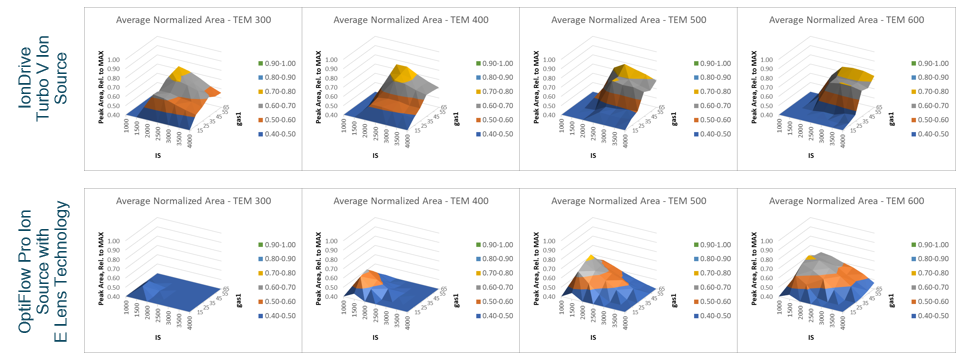The OptiFlow Pro ion source is the fourth generation of source in the Turbo V ion source family. Fundamental to this family of sources is the orthogonal spray design with V heater configuration, which focuses heat in the optimal spot to achieve high sensitivity through high desolvation from the ESI droplets. The OptiFlow Pro source is an all-in-one versatile ion source with interchangeable towers/probes, enablinge users to easily switch between different ionizations and different flow rate regimes. Probe and electrode positions are pre-optimized for maximal performance with no user intervention needed.
With the newest source design there are some optimization behaviors that a user switching from older generation sources should consider. Subtle changes in the source geometry, and in the probe/electrode configuration, as well as the addition of E Lens probe, all contribute to different optimal source conditions than in the previous generation of sources.
Analytical flow tuning – ESI
Both the ionization spray voltage (ISV) and the nebulizing gas (GS1) will optimize to lower values than the IonDrive Turbo V ion source, so it is recommended that users do a quick re-optimization of these two settings when migrating methods over to the SCIEX Triple Quad 7500 system. The heater gas (GS2) has been found to be fairly flat so minimal tuning is required. A setting of 70 for Gas2 works for most experiments.
As an example, the optimization profiles comparing the OptiFlow Pro ion source to the IonDrive Turbo V ion source at 500 µL/min flow rates are shown below for a mixture of small molecule drugs. Note that most compounds optimize to a higher temperature on the OptiFlow Pro source, and that there was a broader range observed on the IonDrive source.
From this optimization effort, we developed some recommended starting points:
- At 500 µL/min – use a TEM of 600, a Gas1 of 35, a Gas2 of 70, and an ISV of 1500 V

Analytical flow tuning – APCI
Fewer tuning differences were observed when comparing the two sources in APCI mode. The nebulizer current was found to optimize at lower settings (0.5 – 3 µA on OptiFlow Pro source as compared to 2-4 µA on the IonDrive source). Also, the Gas1 did tune a little bit lower on the OptiFlow Pro source because of the lower required current.
Recommended starting points:
- For small molecules at 500 µL/min – use a TEM of 400, a Gas1 of 30, and a NC 2 µA
Microflow tuning – ESI
Similar optimization experiments were performed at microflow rates, comparing potential tuning differences between the OptiFlow Pro source (with and without the E Lens probe) and the OptiFlow Turbo V source. As expected, the source tuning was relatively similar between the two sources when the E Lens probe was not installed. Addition of the E Lens prove did impact tuning of the OptiFlow Pro source, requiring a higher GS1 setting to achieve the higher source temperatures (ISV was not impacted).
Recommended starting points (use CUR of 40 and Gas 2 of 70 for all):
- For small molecules at 3 µL/min – use a TEM of 150, a Gas1 of 20, and a ISV of 4500 V
- For small molecules at 30 µL/min – use a TEM of 350, a Gas1 of 45, and a ISV of 4500 V
- For small molecules at 100 µL/min – use a TEM of 450, a Gas1 of 45, and a ISV of 4500 V
- For peptides at 5 µL/min – use a TEM of 200, a Gas1 of 40, and a ISV of 3750 V
References
- For method transfer ideas, refer to MRM method transfer from a SCIEX Triple Quad or QTRAP 6500+ system to the SCIEX 7500 system.
- For more info on general source tuning across the SCIEX suite of source options, refer to General source/gas settings to use when starting method development.
RUO-MKT-18-12014-A



 Contact Support
Contact Support
0 Comments